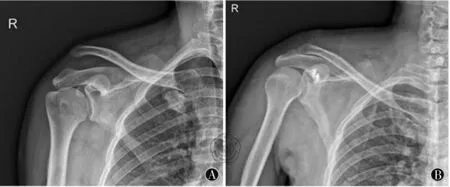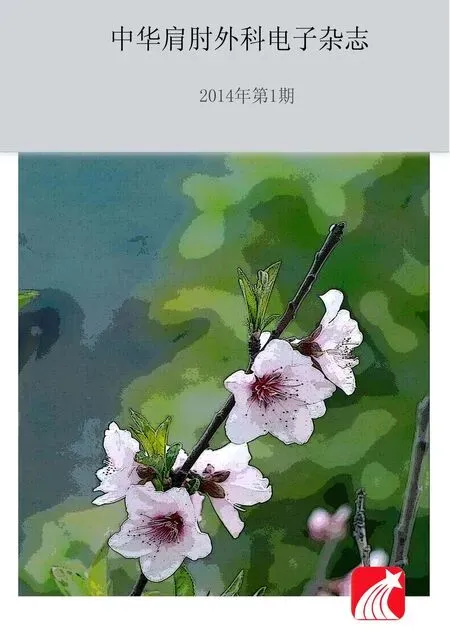自体掌长肌移植重建喙锁韧带结合带线锚钉固定治疗肩锁关节脱位的疗效
2014-07-05罗吉伟余斌魏宽海覃承诃胡岩君
罗吉伟 余斌 魏宽海 覃承诃 胡岩君
自体掌长肌移植重建喙锁韧带结合带线锚钉固定治疗肩锁关节脱位的疗效
罗吉伟 余斌 魏宽海 覃承诃 胡岩君
目的观察自体掌长肌移植重建喙锁韧带结合带线锚钉固定治疗肩锁关节脱位的治疗效果。方法自2011年5月至2012年5月,收治Rockwood分型Ⅲ度以上的肩锁关节脱位患者30例,以自体掌长肌移植重建喙锁韧带,强生带线锚钉固定维持锁骨于复位状态,观察疗效,包括X线片检查复位效果及Rockwood肩关节功能评分。结果术后对30例患者进行随访,平均随访16个月,术后12个月的患肢肩关节 Rockwood评分,优 25例(83.33%),良 4例(13.33%),可 1例(3.33%),差0例(0%),优良率96.7%。结论自体掌长肌移植重建喙锁韧带结合带线锚钉固定治疗肩锁关节脱位效果优良,可成为治疗肩锁关节脱位的一种较好的选择。
肩锁关节脱位; 掌长肌; 重建; 带线锚钉
肩锁关节脱位临床上较为多见,是否选择手术治疗,应根据患者损伤的类型、程度、症状、年龄、职业、运动要求等因素综合判定。肩锁关节脱位按Rockwood分型分为6型(度),一般认为症状明显的Ⅲ度以上损伤是重要的手术指征[1-2]。肩锁关节脱位的手术治疗关键在于复位后,选择合适方法对肩锁关节或喙锁之间进行固定,内固定的选择较多,如克氏针张力带、锁骨钩钢板或解剖钢板固定肩锁关节;空心螺钉、钢丝、带线锚钉固定喙锁[3-8]。在选择这些固定手术时,可结合肩锁关节的清理、锁骨远端的切除或喙锁韧带的缝合或重建等[6-7]。这些术式大部分获得较好的效果,但也有内固定失效、移位以及内固定取出后再脱位等问题发生。鉴于喙锁韧带对于肩锁关节稳定性的重要意义,近年来学者们对喙锁韧带修复重建逐渐予以重视,修复方法包括直接缝合、局部韧带移位、自体肌腱移植、异体肌腱移植等。我们在临床中选择了一种损伤小、技术简便的自体掌长肌移植重建喙锁韧带,结合带线锚钉复位固定治疗肩锁关节脱位,取得满意疗效。
资料与方法
一、一般资料
2011年5月至2012年5月,本院共收治30例Rockwood分型Ⅲ、Ⅳ或Ⅴ型肩锁关节脱位的患者,其中Ⅲ型18例,Ⅳ型1例,Ⅴ型11例;男性23例,女性7例;右侧20例,左侧10例;年龄17~55岁(平均31岁)。所有患者均为单纯的肩锁关节脱位,无合并骨折与神经血管损伤者;其中交通伤28例,击打伤2例。所有患者均为新鲜损伤,就诊时均有肩锁关节疼痛、畸形、活动受限及浮动感等体征,且既往无肩锁关节脱位史。均行术前X线片或MRI确诊为肩锁关节完全性脱位。平均手术时间为伤后8.2d(3~20d)。
二、手术方法
采用气管插管全身麻醉,沙滩椅卧位,患肩垫高,头部转向健侧。沿着喙突向上,做4cm的纵行切口,切开皮肤、皮下组织,显露肩锁关节、喙突、锁骨中远段,在复位前将关节内碎裂软骨盘及软组织清除干净,根据局部损伤情况,必要时可行锁骨远端部分切除术(切除5mm左右)。在证实喙锁韧带断裂无法缝合后,则暂时止血覆盖伤口。(1)掌长肌切取:同侧上肢,腕正中扪及掌长肌,在腕部做1~1.5cm的纵行切口,暴露并向近端沿皮下分离掌长肌,在分离至上臂近端预定切断肌腱的位置,做另1cm的纵行切口,切断抽出掌长肌。根据长度,可将肌腱对折2~3折备用。(2)喙锁韧带重建:锁骨中远端韧带残迹处做2骨道,为防止骨折,两骨道间距不少于1cm。在喙突中部两侧各置入一枚直径5.0mm的带线锚钉,将备用的掌长肌,自喙突下方绕过,两端与锚钉缝线一起分别穿出锁骨上的骨道,在锁骨上方行肌腱缝合与缝线打结。在收紧打结时,注意锁骨上方加压,使肩锁关节充分复位。透视证实肩锁关节复位满意后,冲洗缝合伤口。
三、术后处理
术后颈腕吊带悬吊患肢2周,伤口疼痛缓解后即指导患者做肩关节被动功能锻炼,6周内关节被动活动只限于外展、屈曲90°以内,允许内外旋,6周以后可以逐渐开始全关节范围的主动活动。术后1周、1个月、3个月、6个月和12个月时门诊复查X线片,并评定肩关节功能。
四、疗效评定
记录患者的平均手术时间及术中出血量。疗效根据术后肩关节X线正位片检查关节复位情况,肩关节功能根据Rockwood评分法[1]进行评定,该评分系统包括:(1)疼痛:无3分,轻微2分,中度1分,严重0分;(2)活动范围:正常3分,轻微受限(<25%)2分,中度受限(25%~50%)1分,重度受限(>50%)0分;(3)肌力:正常3分,轻微减弱(<25%)2分,中度减弱(25%~50%)1分,严重减弱(>50%)0分;(4)日常活动受限:无3分,轻微2分,中度1分,严重0分;(5)主观结果:优3分,良2分,可1分,差0分。总分13~15分为优,10~12分为良,7~9分为可,7分以下为差。
结 果
本组患者平均手术时间为65min(40~90min)、术中平均出血量70ml(50~100ml)。术后随访12~22个月,平均16个月。所有患者术后外观均获得改善,无局部隆起、肿胀等。根据Rockwood评分法,术后关节功能优25例,良4例,可1例,差0例,优良率96.7%。所有病例无感染,2例术后3个月的X线片出现肩锁关节向上半脱位,但外观无异常,该2例患者至术后1年复查X线片,关节脱位无继续加重。
讨 论
肩锁关节脱位临床上并不少见,治疗的方法较多,手术适应证存在争议[1,7]。喙锁韧带对于维持肩锁关节的稳定性有重要意义。Rockwood分型Ⅲ度以上的损伤喙锁韧带均已断裂,保守治疗患者可能会遗留不同程度的外观异常、疼痛、上肢肌力减弱,且保守治疗需要较长时间的外固定,可能导致关节僵硬。因此对于年轻及对上肢活动能力有一定要求的Ⅲ度以上患者,手术治疗是较好的选择。目前治疗肩锁关节脱位的手术方法较多,固定肩锁关节的方法有锁骨钩钢板、解剖钢板和克氏针张力带等。将锁骨与喙突固定的方法有螺钉、带线锚钉、Endobutton、钢丝捆绑等。据文献报道[8],这些方法大都能取得较好的临床效果,但也有较多的并发症。如内固定的松动、移位、断裂、撞击等。为了减少内固定的并发症,需要在局部软组织瘢痕愈合后,尽早取出内固定。而内固定取出后,关节发生再脱位的报道也并不少见。因此,一期缝合或重建喙锁韧带,并非单纯使其瘢痕愈合,而重要的是能够获得更好的生物力学稳定性。

图1 男性,43岁,摔伤致右侧肩锁关节脱位 图A为术前X线片示肩锁关节脱位;图B为术后X线片示肩锁关节复位情况
喙锁韧带断裂后较难缝合。重建喙锁韧带的经典术式,如喙肩韧带移位,由于对局部软组织造成进一步损伤,且较难做到解剖点重建,存在应用的局限性[78]。异体肌腱移植可以做到解剖附丽点重建,但有感染、排斥、不愈合的风险。应用自体掌长肌移植重建喙锁韧带,其优点:(1)肌腱切取方便、微创,手术时只需要消毒同侧上肢即可;(2)作为喙锁韧带的移植物,该肌腱大小、长度较为合适;(3)与喙肩韧带移位等术式相比,掌长肌移植可较好的选择附丽点,使韧带接近解剖位置重建;(4)相对于异体肌腱,自体肌腱移植没有排斥风险,可较好地愈合,感染风险小;(5)供区的功能损失可以忽略不计。其缺点:(1)部分患者掌长肌缺如,或特别细小;(2)术前需要留意查体。
带线锚钉的使用为关节提供相对的稳定性和活动度,这样可防止剪切力过大,导致重建的韧带愈合前松弛,同时也为关节盘和其他软组织的愈合提供时间。与单独的韧带重建或缝合相比,结合应用带线锚钉内固定,术后只需要行简单的悬吊固定,且可以早期进行功能锻炼,避免关节僵硬。应用带线锚钉作为内固定材料的优点:(1)使用方便,术野不需大面积暴露,内固定占用空间小;(2)缝线提供的是非刚性固定,保留了肩锁关节微动的生理状态。由于带线锚钉不是刚性固定,术中收紧打结时,需要控制好锁骨的位置,移植肌腱的张力。本组所有病例术后的X线片都显示肩锁关节复位良好,但有2例术后3个月出现锁骨向上的半脱位。这可能是术中肌腱移植物与锚钉缝线的张力控制欠佳,缝线未充分拉紧,锁骨的稳定性依靠肌腱维持,经过功能锻炼,移植物在充分愈合前受到牵拉,出现了迟发型松弛。
该组病例联合带线锚钉与自体掌长肌移植治疗Ⅲ度以上的肩锁关节脱位,可以使两种术式的优点结合起来,最大限度地减少了两种术式的不足,提高了成功率,经临床随访证明为一种有效的手术方法,而且方法简便、创伤较小,可早期恢复正常的功能。本组病例样本量较少,后期需要大量病例的积累和观察。
[1] Fremerey R,Freitag N,Bosch U,et al.Complete dislocations of the acromioclavicular joint:operative versus conservative treatment[J].J Orthopaed Traumatol,2005,6(4):174-178.
[2] Guy DK,Wirth MA,Griffin JL,et al.Reconstruction of chronic and complete dislocations of the acromioclavicular joint[J].Clin Orthop Relat Res,1998,(347):138-149.
[3] 蒋栋,吕书军,洪晔,等.锁骨钩钢板与三Endobutton钢板治疗新鲜肩锁关节脱位疗效比较[J].中国修复重建外科杂志,2012,9(9):1025-1028.
[4] 周江军,朱治宇,赵敏,等.空心钉固定联合半腱肌肌腱重建喙锁韧带治疗Ⅲ度肩锁关节脱位[J].临床骨科杂志,2012,14(2):154-155.
[5] 张克刚,陆芸.带线铆钉治疗TossyⅡ、Ⅲ型肩锁关节脱位[J].中华骨科杂志,2011,13(7):744-748.
[6] Koukakis A,Manouras A,Apostolou CD,et al.Results using the AO hook plate for dislocations of the acromioclavicular joint[J].Expert Rev Med Devices,2008,5(5):567-572.
[7] Lin B,Lian KJ,Guo LX,et al.Comparative study on treating complete dislocation of acromioclavicular joint with three different methods[J].Chin J Traumatol,2004,7(2):101-107.
[8] Wang S,Du D,Zhang P,et al.A modified method of coracoid transposition for the treatment of complete dislocation of acromioclavicular joint[J].Chin J Traumatol,2002,5(5):307-310.
Transplantation of autogenous palmaris longus tendon combined with suture anchor fixation in the treatment of aromioclavicular dislocations
Luo Jiwei,Yu Bin,Wei Kuanhai,Qin Chenghe,Hu Yanjun.Department of Orthopedic and Traumatology,the First Affiliated Hospital of Southern Medical University,Guangzhou 510515,China
BackgroundClinically,acromioclavicular dislocation is a common disease.Whether surgical treatment should be taken or not depends on the type and degree of the injury,as well as the symptoms,ages,occupation,exercise requirements,and other factors of patients.Acromioclavicular dislocation can be classified as six types(degrees)according to Rockwood.The injury with obvious symptoms aboveⅢ degree is generally considered as an important operation indication.The key point in the surgical treatment of acromioclavicular dislocation is to select appropriate methods for the acromioclavicular joint fixation after reduction.There are many choices of the internal fixation to fix the acromioclavicular joint,such as the Kirschner wire and tension band,the clavicular hook plate or anatomical plate for the coracoclavicular joint fixation,and the cannulated screws,steel wires or suture anchors for the coracoclavicular fixation.The selection of these fixations can be combined with debridement of the acromioclavicular joint,the distal clavicle resection,or stitching and reconstruction of the coracoclavicular ligament.Most of these surgical procedures have obtained better results.However,the internal fixation failure,displacement or dislocation after the fixation removal sometimes happened.Considering that the coracoclavicular ligament plays an important role for the acromioclavicular joint stability,researchers has gradually paid more attentions to the reconstruction of the coracoclavicular ligament recently.The repair methods include the direct suture,the partial ligament displacement,the autologous tendon graft,and the tendon graft transplantation.We chose a simple,less traumatic method for the acromioclavicular dislocations,which is autogenous palmaris longus muscle transplant combined with the suture anchor fixation,and achieved satisfactory results.Methods(1)General information:A total of 30cases aged from 17to 55years (mean 31years)with acromioclavicular dislocations of Rockwood typeⅢ,ⅣorⅤ were collected in our study,including 18 cases of typeⅢ,1case of typeⅣand 11cases of typeⅤ.Among all the 30cases,23are males and 7 are females,and 20cases with the right sides and 10cases with the left sides.All patients suffered anacromioclavicular dislocation without fracture and neurovascular injury,28cases of which got injured due to the traffic accident and 2cases owing to hitting.All patients had fresh injuries,and as well as the symptoms of acromioclavicular joint pain,deformity,limited mobility and floating feelings when treated.Preoperative X-rays or MRIs were performed to make the diagnosis that all the patients had a complete acromioclavicular dislocation.The mean time of the operation was 8.2d(3-20d)after injury.(2)Surgical methods:General anesthesia was performed using tracheal cannula.Patients lied on the beach chairs in a supine position and turned their head to the healthy side,and the suffering shoulder was blocked up.Make 4cm longitudinal incision along the coracoid,cut the skin and the subcutaneous tissue,reveal the acromioclavicular joint,the coracoid and mid-distal of the collarbone,remove the intra-articular cartilage fracture fragments and soft tissues before reduction and resect the partial distal clavicle if necessary according to the injury (excision of about 5mm).Stop bleeding and cover the wound temporarily after the confirmation of the inability to suture the coracoclavicular ligament rupture.(1)The palmaris longus muscle cut:touch the palmaris longus at the center of the wrist in the ipsilateral upper extremity,and make a longitudinal incision from 1to 1.5cm at the wrist,and then the palmaris longus is exposed and separated proximally along the subcutaneous.Make another 1cm longitudinal incision on the predetermined cutting position of the tendon of the proximal muscles in the upper arm,and cut and extract the palmaris longus.The tendon can be folded 2-3folds back according to its length.(2)The coracoclavicular ligament reconstruction:make two bone tunnels at the ligament remnants of the distal clavicle,and ensure that the distance of these two bone tunnels is at least 1cm to prevent fractures.Screw a suture anchor with diameters of 5.0mm on both sides of the coronoid process.Make the prepared palmaris longus bypass the beneath of the coracoid process,pierce the two ends of the palmaris longus together with suture anchors along the bone tunnel of the clavicle,and carry out the tendon suture and suture knot above the clavicle.When tightening the knot,pay attention to the exert pressure above the clavicle to make a full reset of the acromioclavicular joint.After the satisfactory reduction of acromioclavicular joint through X-ray fluoroscopy,wash and suture the wound.The mean operative time was 65min (40-90min),and the mean intraoperative blood loss was 70ml(50-100ml).(3)Postoperative treatment:After the operation,hang the limb using the neck wrist strap for two weeks.Guide patients to do the shoulder passive functional exercise after the relief of the wound pain.Begin active functional exercise at 6weeks after the operation.The patients should be reviewed with both X-ray and functional evaluation at one week,one month,3months,6months and 12months postoperatively.(4)Efficacy assessment:Record the average operative time and the blood loss of patients.Make the efficacy assessment according to the X-ray examination of the joint reset condition and the Rockwood shoulder function assessment score.ResultsThe patients in this study were followed up for 12to 22months (mean 16months).The appearances of all patients were improved without the local uplift and swelling.According to the Rockwood shoulder score,25cases got excellent function and 4good,1basically qualified.None case had poor result.The excellent and good rate was 96.7% .All patients had no infection.The cromioclavicular joint subluxation without abnormal appearance occurred in two cases observed through X-ray 3months after the operation,and two patients had no exacerbated dislocation according to the X-ray examination at 1year after the operation.Conclusions The acromioclavicular joint dislocation is common in the clinic.There are many treatment methods for the acromioclavicular joint dislocation.The coracoclavicular ligament is important to maintain the acromioclavicular stability.Coracoclavicular ligaments are broken in the over Rockwood typeⅢ degree injuries.The patients may have varying degrees of abnormal appearance,pain,upper limb muscle weakness,external fixation after the conservative treatment.And the conservative treatment requires a long time,which may lead to joint stiffness.So surgical treatment is a better choice for the young and those with overⅢdegree injuries who have higher requirements of the upper limb activity.Currently,there are many surgical methods for the acromioclavicular joint dislocations.Acromioclavicular joint fixation methods are clavicular hook plate,anatomical plate,tension band and so on.The clavicle and coracoid fixation methods are screw,anchors with wire,Endobutton and wire bundling.According to reports,most of these methods can achieve better clinical results,but there are more complications,such as the internal fixation loosening,displacement,fracture,impact and so on.In order to reduce the fixation complications,the internal fixation need to be removed as soon as possible after the local soft tissue scar healed.And after the fixation removal,the reports of re-dislocation of the joint are not uncommon.Therefore,the primary suture or coracoclavicular ligament reconstruction,rather than making a scar to heal,is theoretically able to get a better biomechanical stability.The treatment of aromioclavicular dislocations with autogenous palmaris longus muscle transplant combined with fixation by the suture anchor has its advantages:(1)It is convenient and minimally invasive to cut off the palmaris longus,and surgery is only needed to disinfect the ipsilateral upper extremity;(2)As the coracoclavicular ligament graft,the tendon size and length are more appropriate;(3)Compared with the other surgical methods,the palmaris longus muscle transplantation is a better choice for the reattachment point so close to the anatomical location of the ligament reconstruction;(4)With respect to the tendon allograft,the autologous tendon graft does not have better healing and less risk of infection;(5)The functional loss for the supply area is negligible.Disadvantages:(1)The palmaris longus of some patients is agenesis or special small;(2)It is need to pay attention to do the preoperative examination.The suture anchor provides the relative stability and activity of the joint,which prevents excessive shear forces to cause the relaxation of ligament reconstruction before healing,and also provides time for the articular disk and other soft tissue to heal.Compared with the separate ligament reconstruction or suture,the combination with the application of the suture anchor fixation requires only a simple suspension after surgery,as well as make the patients do early functional exercise to avoid joint stiffness.Applications with wire anchors as the fixation material has some advantages:(1)It is easy to use,and did not need a lot of exposure of the operative field and a small fixed space;(2)The suture provides a non-rigid fixation which retains the fretting physiological state of the acromioclavicular joint.The treatment of the over Ⅲacromioclavicular joint dislocation for the group of patients with suture anchors and autologous palmaris longus transplantation,can combine advantages of the two surgery,minimize the lack of two surgical procedures,and improve the success rate.It has been proved to be an effective surgical method by the clinical follow-up.Moreover,its application is easy,and it has less trama and help joints early return to the normal function.The samples of patients in this study are not much,we need to accumulate a large number of cases and observation in the future.
Aromioclavicular dislocations; Palmaris longus muscle; Reconstruction; Suture anchor
Yu Bin,Email:yubinol@163.com
2013-07-29)
(本文编辑:李静)
10.3877/cma.j.issn.2095-5790.2014.01.006
510515 广州,南方医科大学南方医院创伤骨科
余斌,Email:yubinol@163.com
罗吉伟,余斌,魏宽海,等.自体掌长肌移植重建喙锁韧带结合带线锚钉固定治疗肩锁关节脱位的疗效观察[J/CD].中华肩肘外科电子杂志,2014,2(1):28-32.
